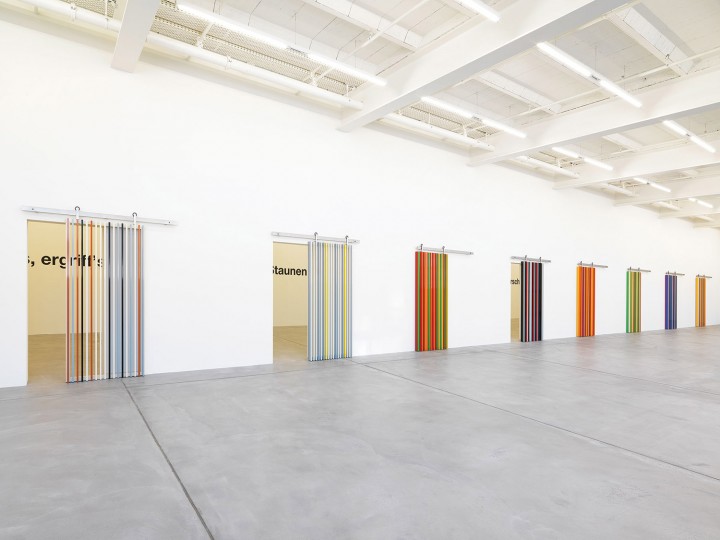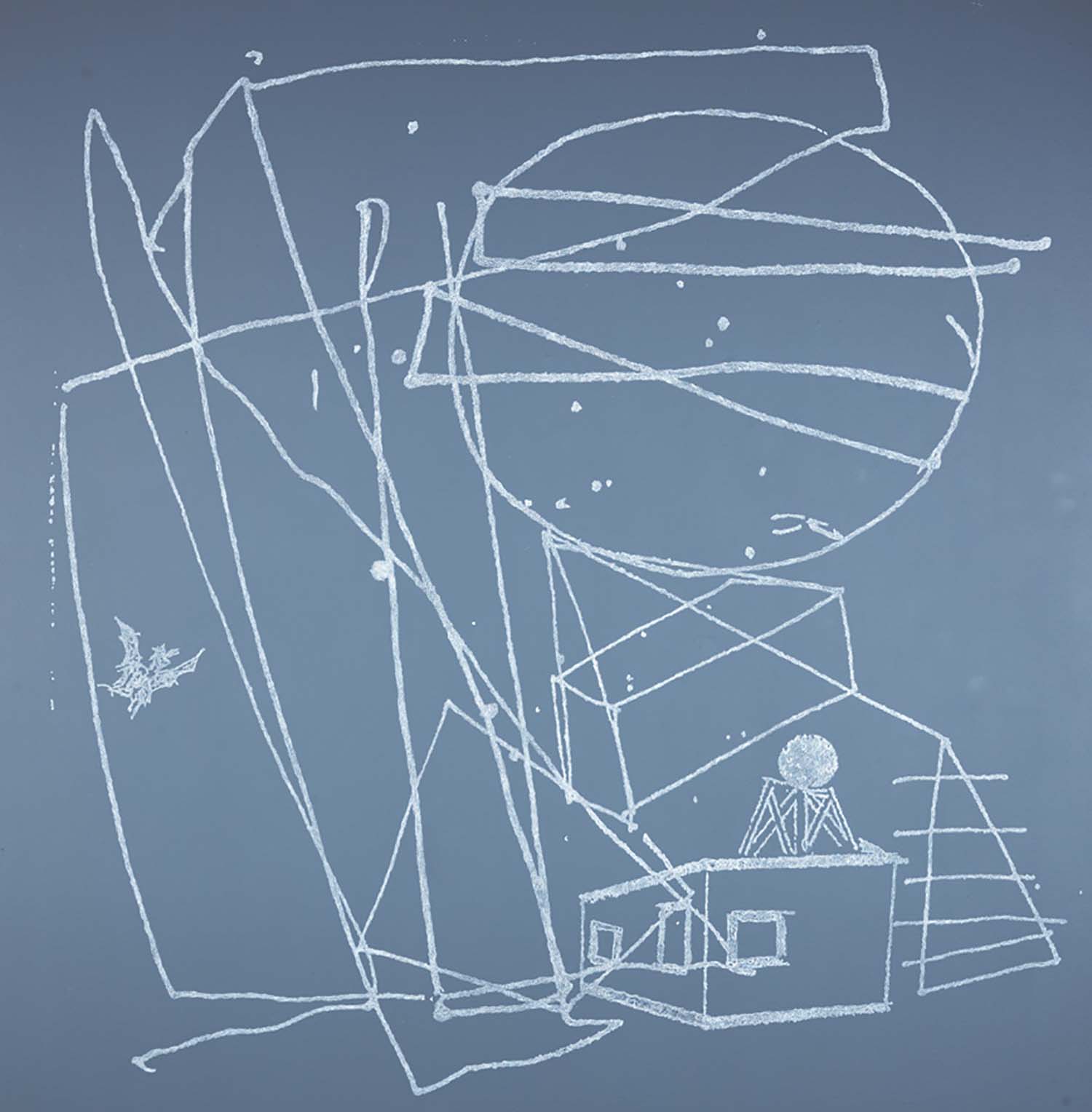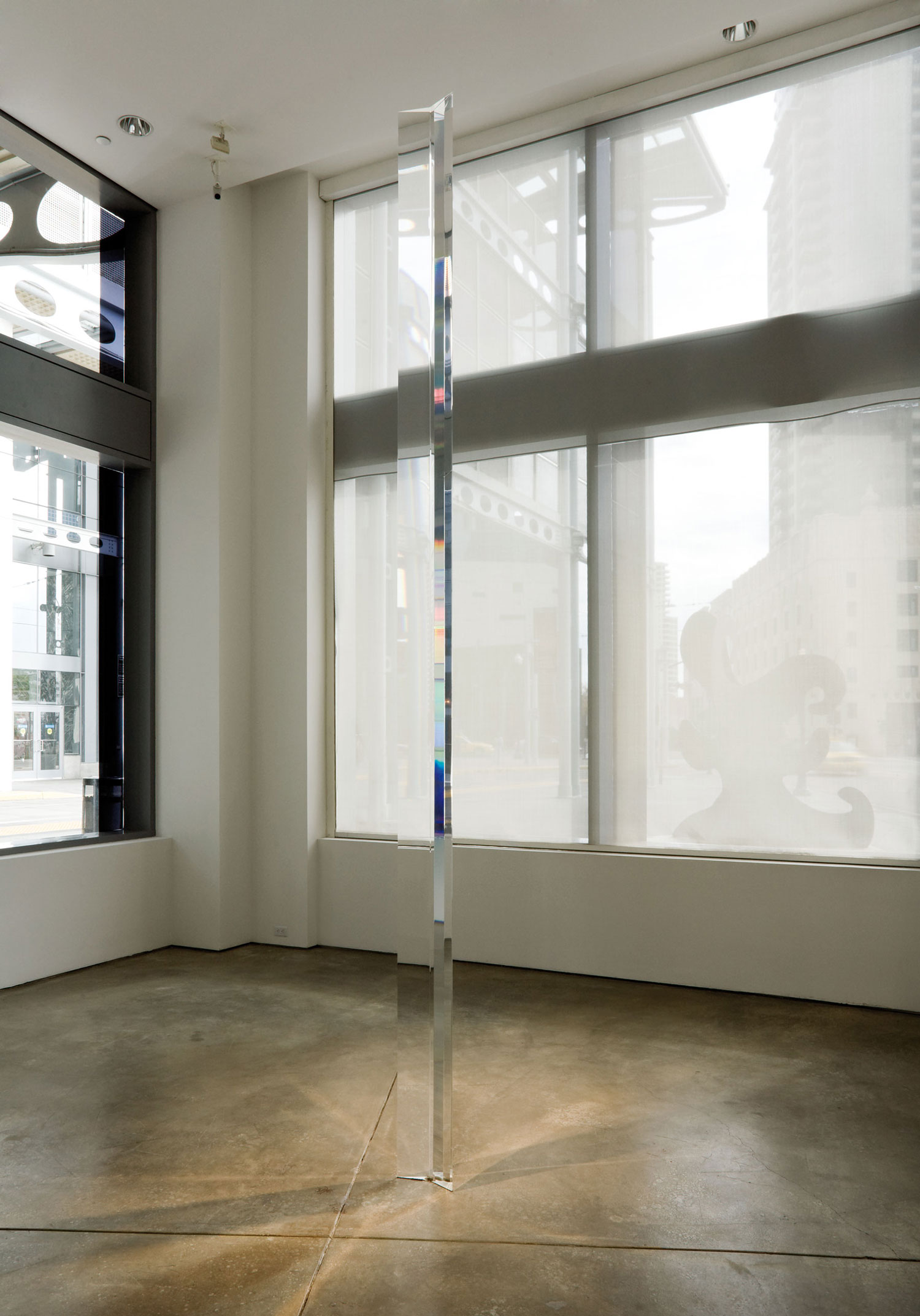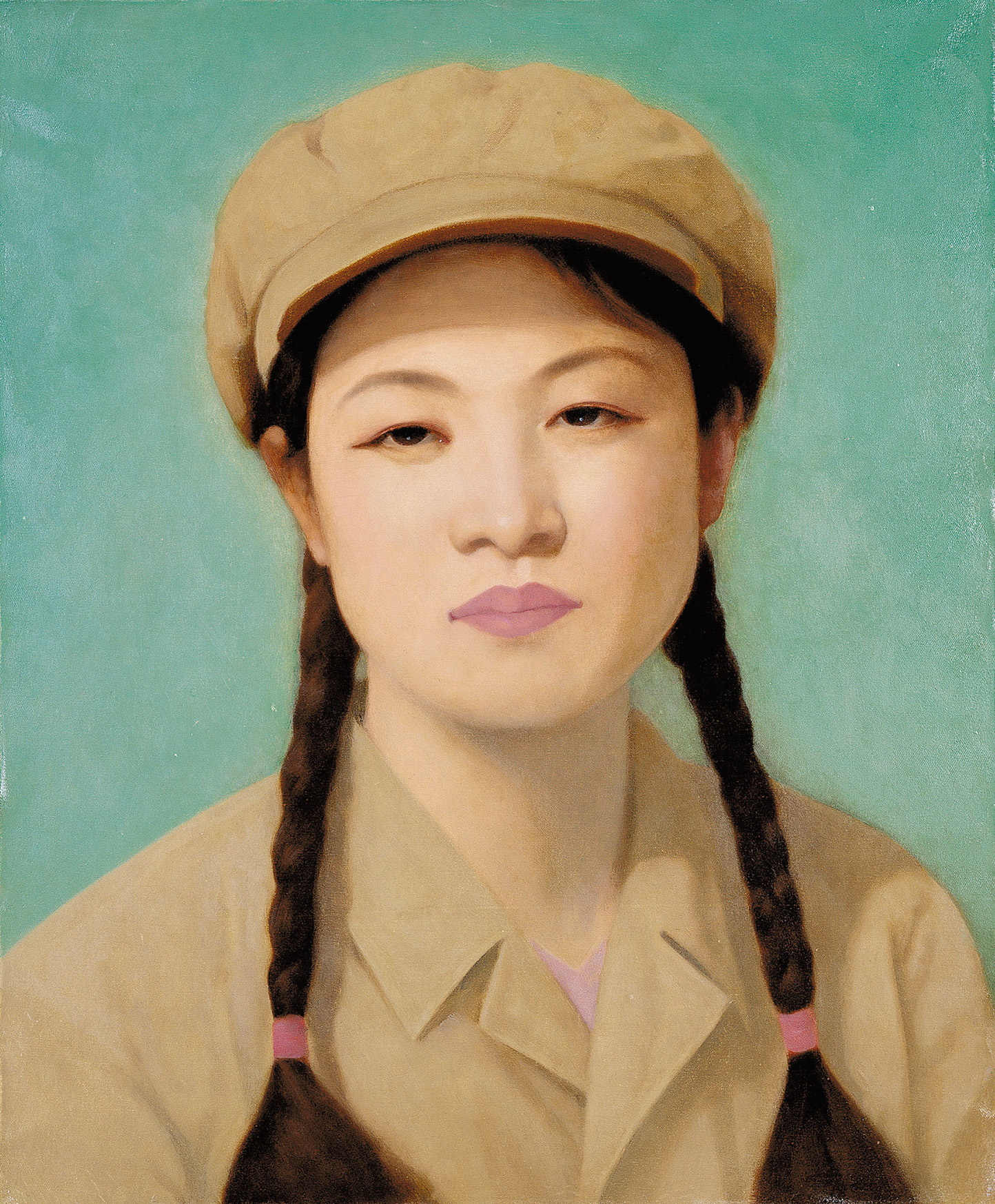
Florence Bonnefous: What is your name?
Liam Gillick: When I was growing up in the North London suburbs it was the time of the IRA bombing campaign in Britain. An Irish name seemed to be a warning and something people pronounced incorrectly. Of course now it is just another name. And at the same time it might be a good time to find a decent pseudonym. I always thought the Autoroute sign south west of Paris might be perfect: Nancy (300 km) Strasbourg (480 km).
Maureen Paley: How has the position of itinerant and/or exile impacted your work?
LG: Working from location to location as I do absolutely affects the work. The ideas require new backdrops and starting points, and this cannot be found in the same place all the time. You and I have moved in opposite directions, which give us both a unique perspective on London and New York — at the very least. What I realize is that the itinerant is the less profound cousin of the exile — someone who wants to produce new ideas in motion rather than being forced into making a commentary from a distance. I am happiest in a critical context. Therefore I have gravitated towards places where there seems to be an accumulation of critical voices. At one point Cologne was that place. It displayed a strong critical sensibility but did not prevent work. New York has also been that place at times. Of course the danger of New York is that it can sustain an intellectual practice both super-conscious of and at the same time insulated against a true confrontation with the real problems of our time. Occupy Wall Street was a perfect example of this. New York is a place where you cannot be a true itinerant or claim to be an exile but you exist within a context that is full of people testing each other.
Uri Aran: Who is the protagonist in your work?
LG: The protagonist in the work is a series of voices — some louder than others. One is in constant conversation with other artists and the work of others in general. Another is in constant battle with its own past — wishing things could have changed or been better expressed. Another important voice is the one corresponding with others. One crucial dynamic of the artist is the relationship to the invitation and the process of inviting. The role of the correspondent is extremely important. It is underappreciated. Lawrence Weiner — for example — is a correspondent of extreme economy and precision.
Gabriel Kuri: A long time ago you told me you rejected the idea of having a studio — a big open space in which to make things quietly, and have stuff and work in progress lying around, like a lot of artists do — because all you could see yourself doing in this set up was rubbish; you felt you were not able to make any good art from that conventional solitary studio practice. I am wondering if this remains unchanged in your modus, or whether there are aspects about conventional studio practice — spatial, temporal or material — that you have come to value over time?
LG: I retain a deep skepticism about the traditional studio, particularly because in big centers the studio is used as a place for others to pre-judge the appropriateness of the work and is suggestive of a certain lifestyle. It is not studio per-se that is the problem but the studio visit. I am in favor of artists becoming and not coming into being — therefore I reject the standard studio model. However I still need to produce and therefore I have places where I can do so. I need to keep a distance from material presence while remaining interested in material facts. The studio starts to become a place where art is produced, and I am not as interested in producing art as the problem of art. Each day I start at an empty table. Often in a new city. This is the only way I have found to ensure that each day I can avoid the question of what to make and instead ask myself if it is useful or interesting to be an artist at all. I am conscious of the potential danger of the artist as peripatetic knowledge worker, but I am convinced that new models of working do not merely lead towards a networked oblivion.

Beatrix Ruf: What is a logo and what is time in conceiving work? And Helen Marten would like to know if you are jealous of anything.
LG: A logo is an abstraction in the service of the accumulation of capital. But of course we also know that a logo floats free of the intended role. It starts to function on its own. This is the point where I become interested. Time is at the heart of the work. At one level there is an accumulation of ideas over time — but these are always ruptured by the start of a new set of thinking. Time therefore is a battle in terms of conception. A battle to stop and an urge to discard certain ways of thinking and begin to accumulate a new set of ideas. This is the hardest part — the claiming of time towards the production of new ideas. The difference is when you are working in a given context like a building or an urban space, then time can accelerate — when presented with a specific context sometimes it is possible to come up with a way to work extremely quickly. So there is no consistency here. A search for slowness and an exhilarating speed. I am jealous of ideas. It is a productive feeling, as jealousy is connected to desire.
Andy Stillpass: Could you comment on how color relates to form in your work? And how does this relationship act on the visual field of the spectator?
LG: I always use the RAL color system that was developed in Germany in the ’20s. I use the pretty restricted palette of about 200 colors. There is no attempt to resolve form and content in the work — but there are some particular processes taking place. Whenever I use RAL I think of the moment that architects and designers moved from the process of swapping samples and bits of paint and trying to match them towards using a universal code system that would produce the same colors each time. That’s the crucial thing for me — the color remains stable and consistent and maybe the form changes. I am never “concerned” about color — it is a way of designating and altering a form. I don’t use any traditional late-modernist distancing devices — randomness, working in series and so on. The use of form and color is only one component of my work that is engaged with a constant battle with the legacy of abstraction, particularly in relation to the relics of modernist applied art and claims for universality. Occasionally in an exhibition context I will try and deploy color in relation to form in such a way as to demonstrate the futility of these older ideas, while at the same time clearly falling victim to the same lures and delusions.

Nicola Trezzi: It seems to me that one of the most important shifts in visual art is the migration of the aura from the work of art to the artist in the ’90s. Do you feel any connection between this migration and your practice?
LG: My generation was the first to emerge where the discussion was more about the context and the curatorial intention than the work itself. The physical work was often not written about, yet there were many reviews and texts. Most of those concentrated on the implications of the work — projected forwards, sideways or backwards in time — but not what was actually presented as a frame or structure. This shift means there has been a very late attempt to re-think the ’90s — often in pseudo-ethical terms — and still not actually addressing what got made. I am not sure I agree with the word “aura.” I think there is a discursive aspect to work, which means that the artist stands alongside the curator and the critic rather than functioning as a passive producer or subject. This gets complicated and can cause problems for people who try and read art now — especially for those who would like to be gatekeepers. The fact that artists are part of a constellation of critical agents does not mean they have taken over the aura of art — good art doesn’t have an aura — it just means they take responsibility for their practice and are no longer merely involved in a simple tension with a perceived public or bourgeoisie or grand critic. I think it all depends on whom we are talking about. For every artist who stands forward there are many who don’t speak, don’t appear and don’t engage. Refusal is still a crucial aspect for artists who are trying to find a way to function. Just because the mainstream is hogged by certain characters doesn’t mean that all artists desire personal visibility.
Benoît Maire: Do you prefer to go to see a play or a movie? And tell us why.
LG: Neither. Cinema is one of the great disappointments of the 20th century. It is the experience of the cinema itself that is a problem. I prefer to watch movies on a computer. It was the computer that saved movies as far as I am concerned — although I know others who said the same thing about VHS cassettes. Plays are something that educated British people were forced to deal with at school — we did play readings all the time. Theater, on the other hand, is a disaster. I stay away for the all the wrong reasons. I am threatened by theater probably. I am so distracted and deluded that I think it is aimed at me. I am a victim of the “evil of theater.” I can see why Religious-authoritarian regimes in history tried to get it shut down. It betrays a kind of disclosed magic. None of this stops me from the process of reading plays or cinema scripts. From 1992, for about ten years, I avoided films completely and only read scripts. I could still sustain those painful artist conversations when cinema saves a dead conversation about the potential of art by shifting the conversation to the imagined power of cinema’s audience and lure. The only problem was occasionally when I would start talking about a scene and everyone would start to look confused due to its having been cut out of the final film. I have written a couple of plays based on televisions programs, but these are for the art context only.

Andy Stillpass: With the closing of Bill’s Piano Bar, have you found a suitable place for drinks in the neighborhood?
LG: I live in mid-town Manhattan, which used to be full of American bars for after-work drinkers. With the emergence of new lifestyle cultures, the banning of smoking and people always offering you a menu when you go for a drink, places have been closing down over the last ten years. I used to have six decent bars in walking distance that were neither fake Irish bars or pick-up joints. These have all gone — including Bill’s — which was a straight piano bar. I am at a bit of a loss and have taken up drinking at home. Recently the New York department of health started putting posters on the bus stops warning of the dangers of smoking and I guess drinking at home. So I am obviously not the only one. There was a good cartoon in a recent copy of the German magazine Stern that showed five people in a bar with some beers and one man holding forth while holding a teacup. The caption read something like, “Now we have gotten rid of all that nasty smoke — how about we institute a special closed off drinking room in the back?”
Eva Presenhuber: Does art have to have a moral value?
LG: Many people muddle up morals and ethics. I am not very interested in moralizing art. There used to be a lot of it around — in the service of nasty religions and diabolical political regimes. Most kitsch art too is extremely moralistic, and a lot of fear of contemporary art appears to emerge from a fear of amorality and a desire to conflate morals and ethics. The idea that art is supposed to show you a better way is not the same as an ethical practice. Ethics is a structure in relation to art that requires constant testing and questioning. Ethical positions do not produce fascism or kitsch. An ethical practice can be one that exposes others via work that refuses to be absorbed by the system or is resistant to easy analysis. One of the problems recently is that ethics has become muddled up with didacticism and pedagogy. There is an idea that the only ethical practice is one that teaches us something. This is connected to the fact that many interesting artists who want to avoid the standard art market are relying on grants, university positions and biennale structures to survive — where it is quite hard to start your proposal by saying, “I am not going to outline how my work will make the world a better place.”
Tom Eccles: What would you like your last thought to be?
LG: I would like it to be, “I always wondered what this would be like.” But I have an awful feeling it might be, “Shit… God is a Mormon? Are you serious?”
Gelitin: How many times have you lied in this interview?
LG: When I said my last thought would be, “I always wondered what this would be like,” I probably should have written, “Ahhhh… that’s better. I wonder if they have got any more of that?” or “Well, I am glad it is not serious…”





